|
|
|
March 2011
Back
to Archives
|
March 8th, 2011
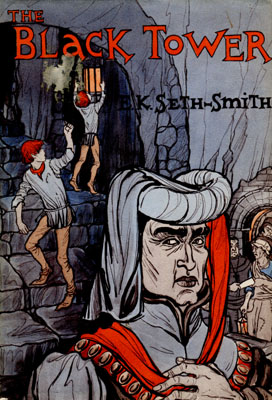
Readying The Boy’s
Tale to go on-line and talking about it with a friend, I
suddenly
remembered (out of some backward-reaching abyss of my mind) when I
must have
met young Jasper and Edmund for the very first time.
Years upon decades ago (in high school, could
it have been?) I read a book called The
Black Tower by E.K. Seth-Smith and afterwards remembered
liking so well
that when I encountered it in a garage sale perhaps twenty years
or more after
I had read it, I bought it. (Garage
sales – or car boot sales if you’re British – are very treacherous
that
way.) It went, unread, into my library
which is (at present anyway) organized enough that when the book
came to mind
again the other day, I was able to find it on my shelves (moment
miraculous).
I find it was published in 1957, nor does it
ever seem to
have had a second edition. Reading it
now, I have the impression that Mrs. Seth-Smith drew her history
and her main villain
from school books; her events and dates are vastly awry from
actuality, but
having said that, I make haste to add that I nonetheless still
find it a
completely charming book – a fairy tale of English history, as it
were, rather
than a spot-on accurate reconstruction, but with the author
creating intensely
memorable characters and a very vivid picture of time and place. As is said on the back jacket flap, “It is a
wonderful story for young people that will whet their appetite for
many, many
more, and will give zest to the study of English history.” But poor Humphrey, duke of Gloucester.
In The Black Tower he’s turned
into far more of an ogre than he ever seems to have been in real
life. In The
Boy’s Tale, too, people have a poor opinion of him (although
not so bad as
Mrs. Seth-Smith!), but since I personally think better of him than
all of that,
I hope to redress the balance when eventually Joliffe is sent to
serve in his
household as a spy. - Margaret |

| March 16th, 2011 Apologies for this being posted a bit late. February got a bit out of hand.... A
MEDIEVAL YEAR IN ENGLAND:
FEBRUARY February fill the dyke
[ditch]
Either with black or white. [rain
or snow]
If it be white, it’s the better to like.
And: All the months
of the year
Curse a
fair Februeer.
The verses acknowledge the month’s uncertain
weather, often
more wet than cold, with chances for flooding and the fens and
marshes
full. But cold is generally preferred to
wet, since this is the month when work in the fields must begin.
Work starts at daybreak this time of year. The harrowing and plowing of the second
fields (those not plowed last autumn) begin early in the month,
around
Candlemas, while spring corn is sown in the autumn-plowed fields
in the first
dry spell. At the same time, the fields
must
be re-fenced against the cattle that have grazed them, and after
plowing comes
the sowing of oats, barley, peas, beans, and vetches (going on
into March).
Much of the work from January also continues: Equipment repaired, hedges mended, pastures
fertilized so the grass will be growing strongly for the ewes when
lambing time
comes. Now is also the time to keep the
land in good heart with manuring, either with animals’ dung and
their soiled
bedding from the barns, or by plowing under green-grown crops, or
by spreading
chalk, marl, lime, seaweed, and the like – whatever is available
to the area.
Now is the time for digging ditches and
planting hedges and
tending to gardens and orchards. Willows
can be well planted now, rooting as they do in wet ground, to give
summer shade
and for later weaving of baskets, chairs, hampers, and other
things. If the chancy weather is too wet
or cold for
field work, then there is still threshing of last harvest’s grain
to be done,
warm work in barns. Along with all else,
there is also week work due to the lord of the manor by his
customary tenants
from now to Easter.
In hunting, the fox, wolf, and hare are in
season from last
month, but hind and roe deer (in season since September 14) and
boar go out of
season at Candlemas.
February 2:
Purification of the Virgin. Candlemas. Candles are blessed in
church, then given out to the people to be carried in solemn
procession and
kept as a strong protection against evil in the following months. This is the end of the Christmas season for
the church, with all Christmas decoration down by now, lest a
goblin or devil
get power in the place. Box branches can
replace greenery until Easter if you wish, while the remains of
the Yule log
are to be burned until sunset, then extinguished and stored away
until next
Christmas.
When the wind’s in
the East on Candlemas Day,
There
it will be till the second of May.
February 3: St. Blaize
Day.
Boys and men light fires to him on hilltops.
For women it is a holiday when they are not
supposed to spin, an otherwise almost-constant occupation when no
other work is
in hand.
February 14: St.
Valentine’s Day.
Tradition says this is the day that the birds choose their
mates. On its eve, men and women in equal
numbers
each write their name on lots, the men then drawing the women’s
names, the
women the men’s. The person whose name
each draws becomes their “valentine” for this day.
So each person is someone’s “valentine” and
has a “valentine” of their own. Each
valentine is supposed to give a gift or treat to their “lord” or
“lady” and
wear their name on sleeve or breast for several days in
light-hearted sport.
Sometime, usually in this month but on any date
between
Candlemas and March 8, comes Shrovetide and the beginning of Lent,
named from
the Saxon word lengten-tide,
indicating the lengthening of the days now in the Spring.
Shrove Tuesday is the day before Lent begins. It is a day for confessing sins and being
shrived – shrove -- by a priest. When
that duty is finished, the rest of the day is holiday for most
people, with cock-fighting,
bull- and bear-baiting, riotous noise-making, football in the
streets for boys
and girls, and children going door-to-door for treats. In the city of York, at least, apprentices
dance in the
cathedral’s nave. Everywhere pancakes
are eaten today, coupled with a contest to see who can toss them
in the pan
most expertly. Customarily the first
pancake is offered to the greatest slut or lie-a-bed in the party,
but since
usually no one admits to this honor, the first cake usually goes
to the dogs or
waste.
Ash Wednesday is the first day of Lent, the
forty days of
fasting before Easter. There are
complicated rules governing what can and cannot be eaten on which
days during
this time. In churches today priests
bless ashes made from the palms consecrated on last year’s Palm
Sunday, then
sprinkle them with holy water and use them to mark a cross on each
worshiper’s
forehead, to remind them that they are of ashes and will return to
dust. It is intended to be a solemn day of
fasting,
with people dressed in mourning black and sackcloth, but there are
also Jack
o’Lents – figures supposed to be Judas Iscariot, dressed in rags
and carried
through the streets, then left out through Lent to be thrown at
and mocked and
finally burned. 
February 1447 - Margaret | 
| March 26th, 2011
A
MEDIEVAL YEAR IN ENGLAND:
MARCH
The Saxon name for this month
is Leneth-monath – length-month – for the lengthening days, the same
word from which “Lent” is derived. It is a dry month with
blustery winds, particularly at its start. The winds may
cause
too much dust but the dryness is hoped for, for the sake of the
ploughing and sowing and harrowing that – begun in February – will go
on all this month.
A peck of March dust is worth a
king’s ransom.
A dry March
never begs its bread.
It comes in
like a lion, and goes out like a lamb.
March dry,
good rye; March wet, good wheat.
And
March many weathers rained and
blowed,
But March
grass never did any good
because
warm, wet weather will start the grass growing too early, so that if
the wind goes around to the east, cold and dry, the grass dies and only
rain can help; but rain hinders planting of the crops and is not
welcome yet. In the hill country of Yorkshire and the
Pennines,
this is often the hungriest month.
It is also the peak of
lambing season and a worrying time. Too much cold will make
the
grass late (the same grass you do not want too early) for the ewes and
their milk for their lambs. And late snow can be the death of
the
newborn lambs.
Meanwhile the work of February goes on through
March. Late spring ploughing, sowing of oats, barley, peas,
beans, vetches; with hedge repairs continuing; and the tending of
gardens and orchards; and scarecrowing in the fields by children to
keep the birds from the seeds; and at the first sign of much grass
growing in the general pastures (rather than the fields needed ready
earlier for sheep) a spreading of fertilizer to bring them
along.
The work owned by customary tenants to the lord of their manor still
goes on until Easter, which may come this month if Lent began in early
February; or Lent may begin as late as March 8 and Easter not come
until late April.
But always at the beginning of March this verse is true:
First come David, then come Chad,
Then come
Winnof as if he were mad.
This
refers to St. David’s day on March 1, when the Welsh should wear leeks,
and to St. Chad’s day on March 2, and St. Winnof’s day (or Winwalloc or
Winnold or Winwaloe) who is the patron saint of stormy wind and tempest
and so very appropriate for early March and its traditional weather.
Mid-Lent
Sunday
– the 4th Sunday in Lent – comes sometime now and is traditionally the
day for people to visit their parents, taking a small
present.
Hence its common name – Mothering Sunday, when folk should go
a-mothering. The expected dish of the day is frumety, which
is
wheat grains boiled in sweet milk, sugared and spiced, along with a
sweet, crusted simnel cake.
Passion Sunday
-- the 5th Sunday in Lent – is sometimes known as Care Sunday, probably
from an old word meaning “grief”, in memory of Gethsemane. In
the
north of England at least the old custom is to have a dish of carlings
(dried peas soaked overnight in water, then cooked with butter) today,
but why is uncertain.
March 17 to
the Irish is St. Patrick’s day, but most popularly in England this
supposed to be the date that Noah entered the ark, and in many towns a
mystery play on that theme will be played.
March 24
is a day for fasting in preparation for the feast day coming tomorrow.
March 25
is the Annunciation to the Virgin Mary. Familiarly called
Lady
Day, this is the day in church and government records that the new year
officially begins, with the date of the year changing.
Everywhere
this is an important day with special church services and religious
processions, but secular activities occur, too, with fools and dressing
up as part of it. If Good Friday comes today – supposed to be
the
date of the actual Crucifixion of Christ – a national calamity is
expected to be coming. Easter coming on this date is no
better.
If Our Lord falls in Our Lady’s
lap,
England will
meet with a mishap.
This
day is also one of the year’s quarter days, when rents are due on
leases. The greater landlords will often given meals for
tenants
who come today to pay on time.
This day is the end of hunting season for fox and wolf (since
Christmastide), but hare-hunting remains an allowable sport.
- Margaret
| 
| March 29th, 2011
MISTRESS
PAYNE'S CLOAK
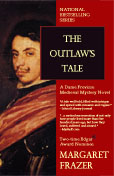
There
was the
sound of footsteps on the stairs. Frevisse went on folding
the last of the linen, finishing as Mistress Payne entered with Maud
behind her. Frevisse and Lovie rose to their feet
respectfully. Mistress Payne fluttered her hands at them from
under an armful of dusty-pink cloth, yards of wool as finely woven as
it was beautifully dyed. Cut threads hanging from the empty
loom in the corner indicated where it had been made, and after Mistress
Payne's flustered greetings, and her own explanation that she was
simply tired of being in Magdalen's room and had been passing the time
in talk with Lovie, Frevisse complimented her on the cloth that Maud
was now spreading out on the bed. “What are you planning to
make?" “I had thought dresses for the girls. But then again I've
thought of a cloak for myself. But I don't know." “Your old cloak is patched in three places along the hem, mistress,"
Lovie said. “It's going to be a disgrace for you to wear it
by next winter. Your girls have gowns enough for the while." “Yes, I suppose." Mistress Payne was not convinced though her
hand lingered lovingly over the fabric. “But I doubt there's
enough here for a cloak after all."
“There is if we turn this the short way," Maud began. She
swept the fabric off the bed and around Mistress Payne's shoulders,
keeping it in place with one hand while holding a length of it out to
the side. “See now, this would work well. We cut
this long end off and make a hood of it, and then cut the center out in
triangle shape, turn it upside down and sew the pieces together, making
a bell-shaped cloak that would be perfect."
“And the color is beautiful on you," Frevisse added.
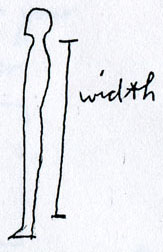 In The Outlaw’s Tale
there is talk of the cloak that’s going to be made for Mistress
Payne. Here, on the chance you would like to make one for
yourself, are simple instructions for the cloak she would have been
making. In The Outlaw’s Tale
there is talk of the cloak that’s going to be made for Mistress
Payne. Here, on the chance you would like to make one for
yourself, are simple instructions for the cloak she would have been
making.
Measure from the center back of your neck to the
floor or whatever length you want the cloak to be. You will
need a piece of cloth at least that width and twice that
long. Fold the cloth in half end to
end: 
Pin the edges together firmly and evenly.
Tie one end of a string to a safety pin. Measure string out
thttp://deltasdnd.blogspot.com/2008/03/1-2-3-infinity.htmlo the width of your cloth and fasten tie the end of the string to a
piece of chalk. You now have a string with a safety pin at
one end and a piece of chalk at the other, as long as the cloth is wide.
Pin the safety pin here, at one end of the fold in the
cloth, and use the string like a compass to draw a
quarter circle as shown here: 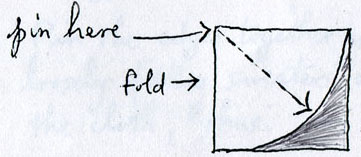
Cut away the shaded portion. You now have a
semi-circle. Hem all the way around it by hand or machine and
you have your cloak.
Place it around your shoulders and
fasten at the center of your throat or else on one shoulder with a
large, strong, fancy brooch (something medieval men wore as well as
women). Or you can buy or make some other form of
fastener: double brooches and a chain or decorative cord
between; decorative frogs with loop and toggle; whatever suits you. 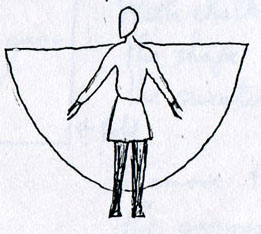
Made of wool or some other warm natural fabric, it’s an
elegant wrap for winter. Lined with fur (artificial, I’m
going to presume), it’s lovely to envelope yourself in on those winter
evenings when you’ve turned down the thermostat and want to curl up in
comfort. Made of lighter fabric, it can be a graceful summer
garment. 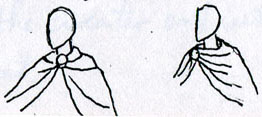

Download PDF
Instructions
- Margaret
| | |

|
|

|
|

|
|
|
|
|
|
|